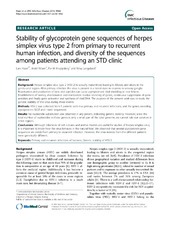| dc.contributor.author | Haarr, Lars | en_US |
| dc.contributor.author | Nilsen, Arvid E | en_US |
| dc.contributor.author | Knappskog, Per | en_US |
| dc.contributor.author | Langeland, Nina | en_US |
| dc.date.accessioned | 2016-01-14T13:33:09Z | |
| dc.date.available | 2016-01-14T13:33:09Z | |
| dc.date.issued | 2014-02-06 | |
| dc.Published | BMC Infectious Diseases 2014, 14(1:63) | eng |
| dc.identifier.issn | 1471-2334 | |
| dc.identifier.uri | https://hdl.handle.net/1956/10960 | |
| dc.description.abstract | Background: Herpes simplex virus type 2 (HSV-2) is sexually transmitted, leading to blisters and ulcers in the genito-anal region. After primary infection the virus is present in a latent state in neurons in sensory ganglia. Reactivation and production of new viral particles can cause asymptomatic viral shedding or new lesions. Establishment of latency, maintenance and reactivation involve silencing of genes, continuous suppression of gene activities and finally gene activation and synthesis of viral DNA. The purpose of the present work was to study the genetic stability of the virus during these events. Methods: HSV-2 was collected from 5 patients with true primary and recurrent infections, and the genes encoding glycoproteins B,G,E and I were sequenced. Results: No nucleotide substitution was observed in any patient, indicating genetic stability. However, since the total number of nucleotides in these genes is only a small part of the total genome, we cannot rule out variation in other regions. Conclusions: Although infections of cell cultures and animal models are useful for studies of herpes simplex virus, it is important to know how the virus behaves in the natural host. We observed that several glycoprotein gene sequences are stable from primary to recurrent infection. However, the virus isolates from the different patients were genetically different. | en_US |
| dc.language.iso | eng | eng |
| dc.publisher | BioMed Central | eng |
| dc.rights | Attribution CC BY 2.0 | eng |
| dc.rights.uri | http://creativecommons.org/licenses/by/2.0 | eng |
| dc.subject | Primary and recurrent infections of humans | eng |
| dc.subject | Genetic stability of HSV-2 | eng |
| dc.title | Stability of glycoprotein gene sequences of herpes simplex virus type 2 from primary to recurrent human infection, and diversity of the sequences among patients attending an STD clinic | en_US |
| dc.type | Peer reviewed | |
| dc.type | Journal article | |
| dc.date.updated | 2015-11-25T09:45:23Z | |
| dc.description.version | publishedVersion | en_US |
| dc.rights.holder | Copyright Haarr et al.; licensee BioMed Central Ltd. 2014 | |
| dc.identifier.doi | https://doi.org/10.1186/1471-2334-14-63 | |
| dc.identifier.cristin | 1156009 | |
| dc.subject.nsi | VDP::Medisinske fag: 700::Klinisk medisinske fag: 750::Infeksjonsmedisin: 776 | |
| dc.subject.nsi | VDP::Midical sciences: 700::Clinical medical sciences: 750::Communicable diseases: 776 | |
| dc.subject.nsi | VDP::Medisinske fag: 700::Basale medisinske, odontologiske og veterinærmedisinske fag: 710::Medisinsk genetikk: 714 | |
| dc.subject.nsi | VDP::Midical sciences: 700::Basic medical, dental and veterinary sciences: 710::Medical genetics: 714 | |
| dc.subject.nsi | VDP::Medisinske Fag: 700 | en_US |

